-
Posts
1,394 -
Joined
-
Last visited
Content Type
Profiles
Forums
Gallery
Events
Blogs
Posts posted by Ben the Ignorant
-
-
1 hour ago, Marvin Jenkins said:
How are your skies in New Mexico?
Same question for me, what is your sky like?
-
6 hours ago, marcelteaching said:
Does anyone know what the optical quality of the early TAL is like?
No, but if you take pictures of the defocus patterns, close to focus and far from focus, on both sides, and maybe get a 40€ Ronchi tester, it can be shown and discussed.
-
On 03/11/2019 at 16:55, Stu said:
I don't know anything about the Lacerta unfortunately but suspect it is a clone to the TS
The outside doesn't look the same, the Lacerta's objective is a clone of the William Megrez 72, and the focuser is a 2" unit when the TS has a 2.5" focuser. Lacerta has 8 ball bearings to support the focuser, which they say can take a 2 kilos payload.

Also, three Lacerta 72's that Teleskop Austria's boss tested had Strehl factors between 96% and 97%. But I have no personal experience with the thing, all I can say is Teleskop Austria's service and pricing is great, and the boss is a competent optics tech who can optimize apos, even respacing the lenses when needed.
-
51 minutes ago, marcelteaching said:
I was going to put in something better than a GSO
Many people assume GSO is just average or subpar quality because it is mass-produced and "not expensive enough", but that ignores two decades of progress in machinery and the plain good will and competence of GSO and its dealers. Looking at hard data from labs, this is what is found when testing two 16-inch GSO parabolic newtonian mirrors:
A 0.93 Strehl ratio; Astro-Physics, LZOS, Takahashi, Vixen and TEC promise 0.95 Strehl ratio in their "expensive enough" apos but the surfaces they produce are never as large as 400mm, so GSO did an excellent job. The test dating from 2008 the mirror is at least that old, so the tooling and/or the know-how at GSO might well have been improved since. That 1/24th wave surface quality is great work for such a large area to polish.
Now watch this:
Another super-large GSO parabolic newtonian mirror, with 0.98 Strehl quality factor! 1/8th wave peak-to-valley, and a nearly science-grade or military/espionage-grade 1/42th wave overall surface quality! Date is the same, lab is that unmerciful Wolfgang Rohr. The complete page is here:
So, if GSO can make such splendid 400mm mirrors, how difficult do you think it is for them to produce an excellent 28mm mirror?
-
 1
1
-
-
18 minutes ago, markse68 said:
Don’t know the answer to your question except increasing secondary obstruction reduces contrast I think
Yes, it does.
-
Teleskop Service has 25mm, 28mm and 31mm diagonal mirrors with 94% reflectivity.
The 94% reflectivity figure is typical of GSO so these are probably made there. The first two letters in their product code, GS, suggests the same origin, so they should be very good.
-
Something that's more for the common stargazer: APM and Teleskop Service have issued a 100° 13mm eyepiece priced at 249€.
I've long been dismayed by the 15mm 100° being featured among the other focal lengths (20mm, 9mm, 3.5mm and 5mm), but always tagged as "unavailable". Well, now a substitute of a similar focal length is "in stock", and the cost is reasonable for a 100°, although it's above my personal limit of 200€ per eyepiece. We're talking usable things in the real world, here, not collectibles that people will be afraid to pull out of their box.
The circle of collectors is strange; here is a story I read somewhere: one guy had a super-expensive replica of a vintage Wild West revolver, probably engraved and silver-plated or whatnot. He presented it to a friend who also liked old weapons, but was not into the world of collecting, so he didn't know their particular rules. He handled the revolver, and cocked the hammer once to feel the mechanism, wanting to appreciate the surely fine tolerances in the action.
Well, collector revolvers are not only not supposed to be fired, but also not supposed to be cocked, not even once, because the moving parts will leave magnifier-level wear lines on each other, greatly reducing the price, at least in the mind of said collectors. Of course someone outside their world is not supposed to know, but the revolver's owner "terminated his friendship" with the offender who wrongly assumed mechanisms are meant to move.
I suspect the Apollo 11 eyepiece would also lose a lot of value if the barrel was ever touched by a brass compression ring (but maybe not a rubber Twist-Lock), or even worse, a locking screw!
-
I am no metallurgist but I have observed this comparing steel and aluminum telescope tubes: the region around the small newtonians' (130 and 150) focuser bends, probably because the kind of steel that can be rolled into a tube shape has to be springy.
I have never, however, noticed any bending with aluminum tubes, probably because they are made of an extruded or centrifuge-formed rigid alloy that doesn't have to be flexible in order to be shaped into a cylnder. Not even the cheap toyish 60mm/800mm achromat I restored had any visible flex, despite being quite long relative to its diameter.
Then again, my GSO 300mm dob with a steel tube doesn't flex around the focuser, and doesn't sag over its 144cm length, not enough to change optical alignment, anyway, the essential is remaining within tolerances. The GSO steel seems to be a thicker and more rigid kind of steel, and looks like it calls for tougher machines to be rolled into a tube.
Overall I prefer aluminum because the tube is seamless and kinda forged by the pressure of extrusion or the centrifuge process, I guess. All the high-end apos have aluminum tubes or a composite called Krupax in the case of APM. It seems to have the qualities of aluminum but doesn't get frosted or dewy when the air is very cold.
Edit: I own only one carbon fiber scope, and it's a small 80/560 so not much experience but when taking it apart to blacken it better, and add baffles, the material felt very rigid. None of steel's springiness, but the same mild flexibility as alu when conducting the very scientific testing of pressing the dewshields inside my hands to feel and observe the deformation. Carbon wins in lightness, yes, BUT it makes the scope unbalanced toward the focuser so I had to make a quite heavy counterweight for the scope's front end. Other properties come into play.
-
I also have a C5 😁. Had to recenter the secondary and the plate but now it's very sharp.
-
 1
1
-
-
Everything I've read about the Sky-Watcher 72 is good but to make things less subjective here is a Ronchi and defocus test (made by Teleskop Spezialisten):

The sharp lines in the Ronchi pattern mean the lenses have an excellent polish, and the fact they are straight means there are no aberrations due to their shape. The large defocus patterns have the same white color so no chromatic aberration to speak of. There is a very small zone in the middle of the small defocus patterns but it's negligible, and the very faint violet and green outer rings are the extremely low level of residual chromatism that all apos have to some degree. Overall an excellent lab test for the 72. Best of all, the rings inside the patterns have very nearly the same brightness, sharpness and color on both sides so none of that spherical aberration gremlin, the number one enemy of contrast.
I wish I could test all the telescopes myself but that's not possible 🙄. The TS scopes have a 2.5" rack-and pinion focuser that should slip less than the Crayford on the Sky-Watcher scope, and the larger drawtube will make for better illumination if you do imaging.
One last thing, if you go from a 102mm scope to a 72mm scope, the reduced brightness and resolution might disappoint you, so if I were you i'd take the largest smaller scope. The gain in tightness of focus will make for some of the loss in sheer amount of light.
-
 1
1
-
-
On 27/10/2019 at 21:37, Neiman said:
A hell of of a lot of the stuff I slew to I cannot see. Especially nebulae, I can see smudges that I get excited about ie The Andromeda Galaxy. But Bodes and the Pinwheel there’s pretty much nothing there along with a host of M numbers and NGC numbers.
is this normal ? Are some of these targets only visible with the correct filters ?
something dumb but I just don’t know if this is normal OR there’s something wrong ? ?Look carefully for predictions of DRY air, cloudless doesn't mean dry. And reserve those nights for observing if no obligations are in the way; even inside a city an air mass free of haze does a lot to help see the fainter targets. Of course a darker countryside sky does more but better have both. I can't help but blame the people in charge of public lighting worldwide, except for places like Arizona where there is enough of an organized public mind to keep light pollution at the very lowest level.
All the current problems due to light pollution, save for those lately-discovered impacting human health, were known and solved on paper in the 1930's, and yet the solutions are applied to only a few rare places. Like only lighting engineers and elected officials have no internet, and never got the memo that's clamored everywhere for decades: don't waste energy, and don't go ruining nature!
-
 1
1
-
-
On 28/10/2019 at 14:18, Rob Sellent said:
I've read that tryng to tie bean bags to the lens end of the scope might do the trick, but this just seems like too much bother
Making some sort of counterweight is the only solution I know to balance problems.
-
 1
1
-
-
A star test is good only when the optics are placed well relative to each other. If there's a misalignment somewhere, it's not in the optics.
-
6 hours ago, Merlin66 said:
The bottom Rochi definitely shows "wavy" lines
That's the sign of zones, not spherical aberration.
Anywhere you look, wavy lines mean zones. German, italian sources, all of them. Look for the wavy pattern on this page:
https://www.otticasanmarco.it/supporto.asp?faq=36
The comment reads:

Anello rialzato, zona circolare sotto corretta
Meaning "Raised ring, circular undercorrected zone".
The Ronchi tester sold by FLO has the same leaflet, and it says the same, as Steve will confirm if he reads this.
-
34 minutes ago, John said:
How do you collimate accurately without a centre spot on the primary ?
The way they collimated their scopes for centuries before center spots, with a slight defocus that creates two or three rings around the central dot. This example is from an achromat I centered but it would look the same in a newtonian because a very small defocus pattern makes the secondary shadow disappear.

The fewer the rings, the more a decentering or miscollimation displaces the dot from the center of the pattern. This is more precise and foolproof than center spots, chesires, lasers of whatnot because it measures the relation between the optics and nothing else. The method works for Schmidt-Cassegrains, newtonians, refractors, and maks.
-
 1
1
-
-
Can't get away from turbulence so the Capella defocus pictures were totally useless. But the Ronchi patterns are not magnified like the defocus test stars so, by averaging them in your mind you can see the main point in this discussion: the lines are not concave or convex, shapes which appear when the optics' overall curvature is not right. The lines are parallel and only a parabola aimed at a star can do that.




I might try another intrafocal/extrafocal defocus test before dawn, Procyon and Betelgeuse are bright and will be placed well in front of my east window. But, Steve, why don't you pull a couple 130/900's out of their cartons, and do a proper Ronchi and defocus experiment with a proper artificial star? If it's a 9µ the distance needs to be only about 40 meters; my flat doesn't allow more than 7 meters, or the scope would have to have 7 or 8 cm more in backfocus.
-
Still no luck with the weather but in the meantime I thought I'd show the thin spider the 130/900 got:
That was before the final tweaking and matte black painting that would make it more difficult to photograph. The cylinder holding everything together is divided in four sections by the vanes so it was more practical to place four collimation screws. They are small but the piles of serrated washers make for a good grip. They are moved by adjacent pairs, by the same angle, of course. So the secondary's motions are left/right, up/down, lined up with the vanes, simpler than the usual triple axis that doesn't match motion in two directions, which is always a two-axis arrangement except in the strange world of telescope collimation.
The cell had those annoying push-pull screws that required a different screwdriver for the collimation and the locking, if I remember well. (Or was it in my brother's Celestron newtonian?)
Anyway, those rubberized tool-less knobs now do the collimation, and the counterpush is provided by tough little springs. To keep them in place while I handle the cell, foam rings are put between the springs and the screws. Removing the cell from the tube is done with those same knobs, couldn't be simpler. The 130/900 is short enough that you can collimate it while you look inside the focuser. The mirror's bevel and edge have been blackened with a felt pen. Light scatter has been suppressed in the bottom of the tube but it still needs a few baffles along its length. The scope is very sharp and that warranted the extra work.
-
 1
1
-
-
I just tried a star test and a Ronchi test on Capella, wanting to take pictures of them, but heavy haze and clouds interrupted me. The air around big masses of haze and clouds is agitated anyway, so even the so-so brief clearings were not good enough. I'll try again before dawn.
-
No, I assumed everyone had noticed I always quote prices in €. And noticed my english is sometimes flawed. 🤨
-
4 hours ago, FLO said:
Their price is £25 higher than ours (£155 at FLO, £180 at the German retailer). Their higher price would make sense if they have specified a parabolic mirror but Synta/Sky-Watcher don't normally offer variants (though it is possible)
More likely because of the exchange rate; I've bought 100°-110° eyepieces from the UK, 15%-20% less than on the continent. I hope owners of these telescopes will star-test them, possibly Ronchi-test them with pictures and show the result.
I've advised my friends to buy their astro gear from the UK, but they already knew. 😁
-
I asked this to TS:
Hello.
Can you please answer a question about the Sky-Watcher 130/900 newton? ( https://www.teleskop-express.de/shop/product_info.php/info/p4778_Skywatcher-Explorer-130---130-900-mm-Newton---optischer-Tubus.html )
Some people in a forum say it has a spherical mirror but I star-tested it, and the main rings (the outer ring and the ring around the secondary's shadow) have the exact same brightness on both sides of focus, which pleased me a lot when I saw it. No spherical aberration is showing at all.
With the 10 lines/mm Ronchi I recently bought from you, the lines are totally straight and parallel, which only a parabolic mirror can do when looking at a star at infinity. It was specifically advertized as parabolic when I bought it in 2015, and that's why I chosed it; it proved very sharp on the Moon, more than my Celestron 5. I made a smaller secondary holder and a thinner spider for better contrast.
Despite that, some are still saying all the 130/900 have spherical mirrors but I believe a spherical mirror couldn't be that sharp and contrasty. So, what do you say?
Thank you for your attention.
And that was their answer:
Hello,
it has a parabolic mirror as all newtonians well made. A spherical mirror will introduce spehrical aberration if there is not a corrector plate (schmidt-newtonian or schimidt-cassegrain). as you well noted, you have no spherical aberration due to parabolic mirror
Freundliche Grüße | Kind regards
Riccardo Cappellaro
Someone from this forum had asked the same question in the year I bought the 130/900...
...and got this answer:
I have had a reply from Edgar at TS Optics who concedes that the "ff7.9" figure is incorrect and will be changed to F6.9, but also says "yes it has a parabolic mirror!"
Skypoint says the 130/900 is paraboloidal (which is the right term but everybody says parabolic for short)
And someone from an older thread here has this to say:
Spherical mirrors will work if the focal length is high enough (and has a theoretical Strehl of 0.80 or higher).
A 130 900 will not have 0.80;
100*e^-(2*pi*( (130/2)^4/(2*900)^3/16/0.00056)/3.5)^2 = 68.65
And this is not factoring in obstruction, roughness of the mirror, bad edges and other errors, but it purely the theoreticly possible.
A 68% Strehl would not be acceptable, and if Sky-Watcher couldn't make an affordable 130mm f/7 parabolic when they can make affordable 130mm f/5 parabolics which are a bit harder to produce, that would be strange. Not to mention how do they figure the large ones that are well-made and not expensive?
The 130/900 TS sold me clearly has identical diffraction rings on both sides of focus and straight Ronchi lines, and only a parabola can provide that. A slight deviation from the ideal parabola shows in the tests, so no parabolizing at all would show more but it doesn't.
So, Steve, can you ask your provider(s) about that, and can you star-test and Ronchi-test one of your 130/900's to sort this out? You do have Ronchi gratings so that should be easy.
https://www.firstlightoptics.com/specialist/gerd-neumann-ronchi-eyepiece.html
-
From Jean Texereau's How to Make a Telescope:
To satisfy the Rayleigh criterion, therefore, the defect on the glass may not exceed 0.14 / 2 micron. That's 0.07 micron.
And:
If the f number is large enough, i.e., if the mirror is relatively shallow, the difference between the parabola and sphere becomes very small; in fact the uncorrected spherical mirror may satisfy Rayleigh's rule and give a practically perfect star image.
BUT:
The Rayleigh criterion must be qualified for low-contrast images. The situation here is much less favorable than in viewing a star. Francon, studying planetary detail of minimum visible contrast, found that a wavefront of 1/16 lamba begins to be objectionable. This implies a tolerable error in the mirror surface of 0.02 micron. The difficulty here is not in making the mirror to this precision,...
So, separating star dots with a mirror deviating from the ideal parabolic shape by 0.07 micron is possible but solar, lunar and planetary detail is not made of bright round disks separated by a hard-contrast black space. It is more subtle, and continuous so it requires a 0.02 micron accuracy mirror, a 3.5 times smaller tolerance.
-
From the Cloudy Nights link that johninderby posted:
Actually for a parabolic mirror: when tested using a Ronchi grating eyepiece, the image of the lines WILL be straight, as object(star), is at virtually infinite distance, (light is coming in as a cylinder, with parallel sides), so focuses at focal plane, whereas, when using the grating as a bench test, grating and light source, are located at (near), the "Radius of curvature"(2x "focal length"), of the mirror. In this case, the light incident to the mirror, arrives as a diverging cone. Mirror surface modifies this cone.So the returning light beam, forms the reverse identical cone (converging).This cone of light is less steep (1/2) than the cone coming from an infinite light source, hence the image of the lines take on the curved shape of the classic parabola.
All telescopes, no matter the complexity and whether aspheric elements are present or not, should present parallel and evenly spaced Ronchi bands on an infinitely distant target. All are interpreted identically, for one is examining only the final wavefront--which is nominally spherical--near the focus.
I'm obviously not removing the mirror when I test my scope, so parallel lines it has to be, as in the photo I took. Turbulent but parallel.
-







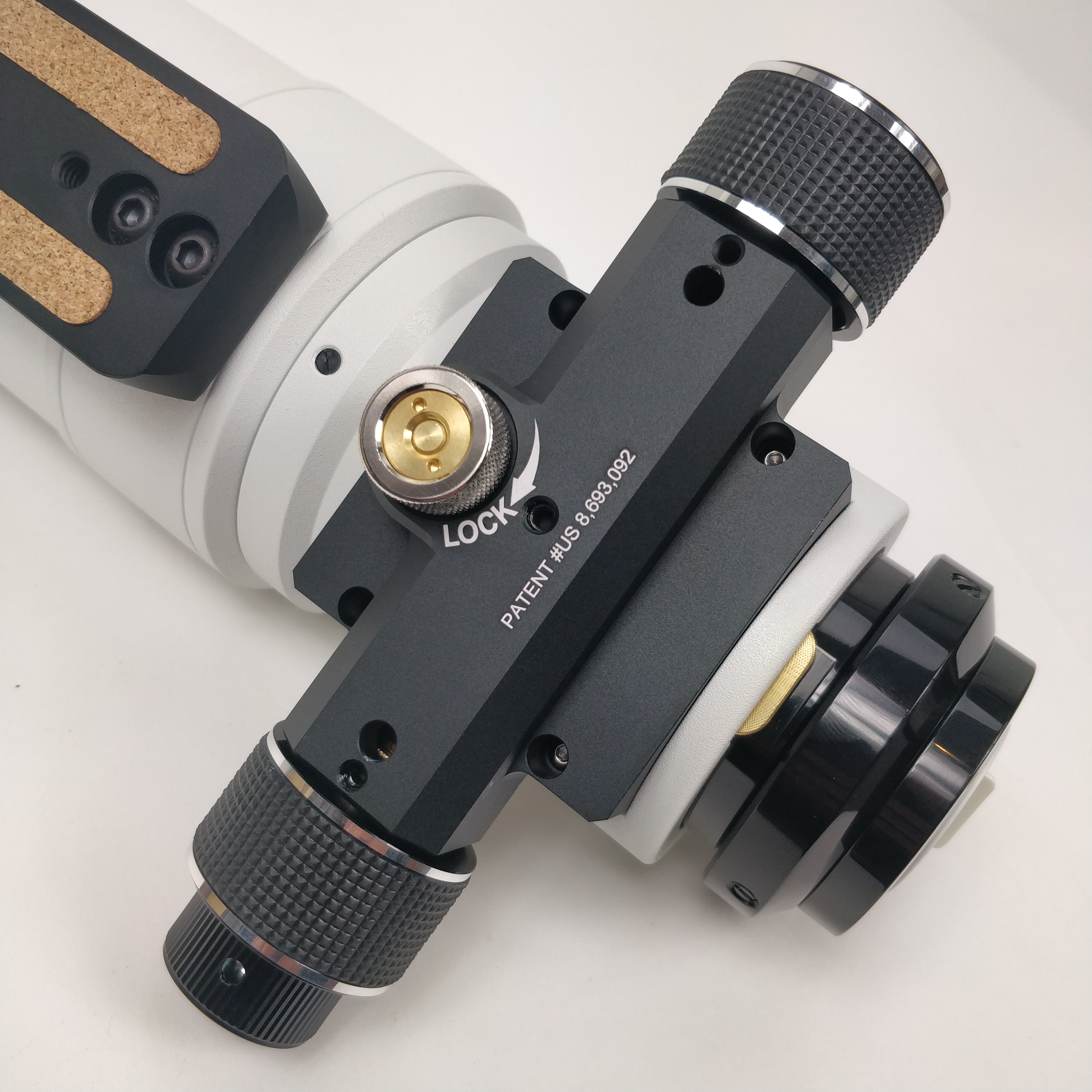
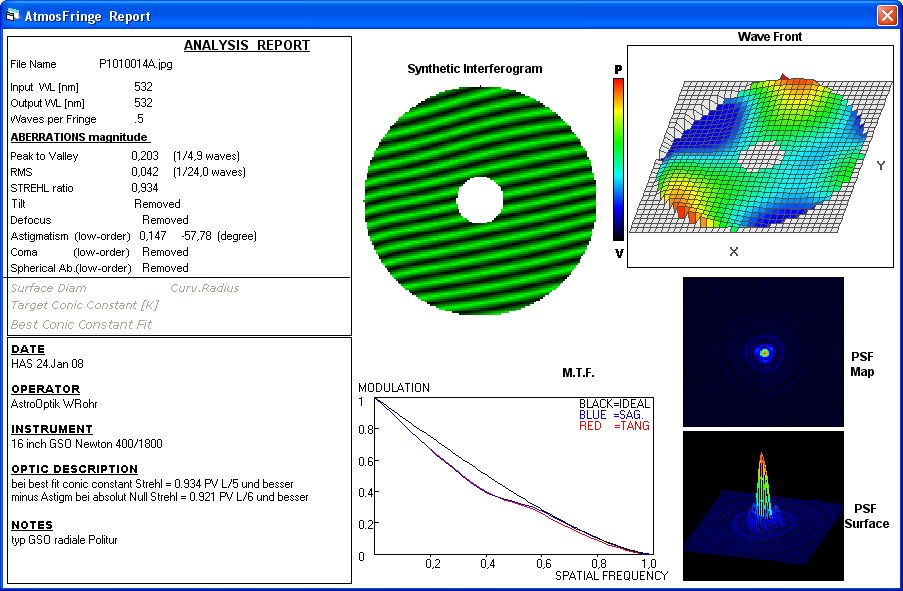
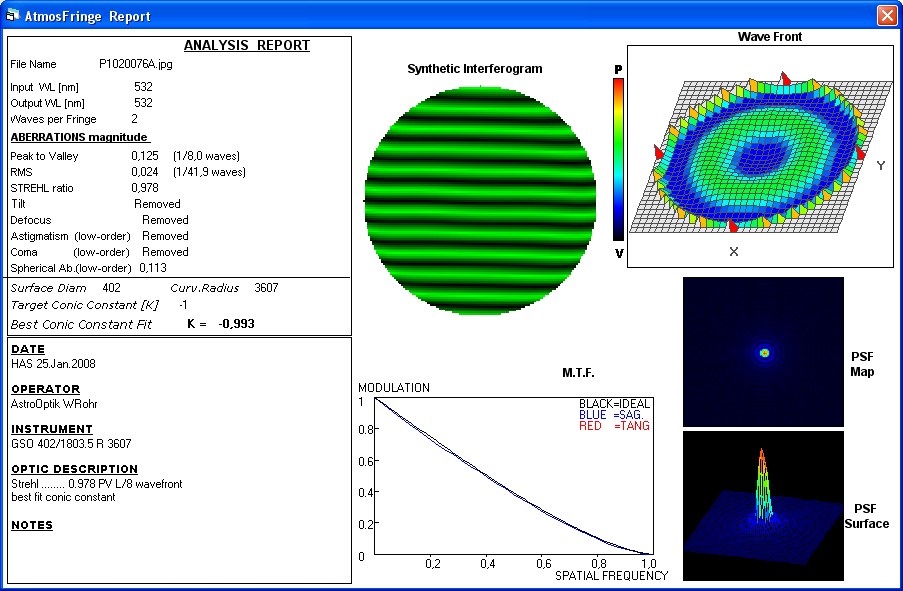

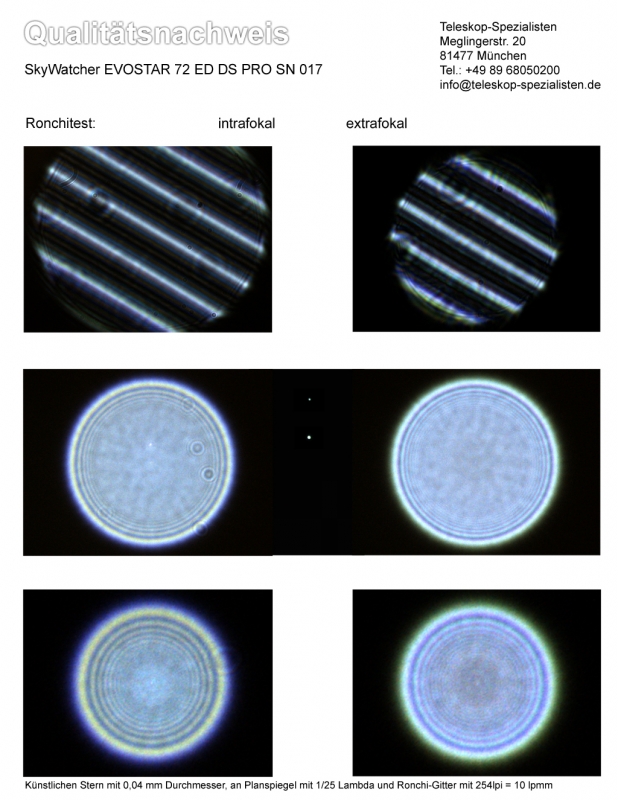















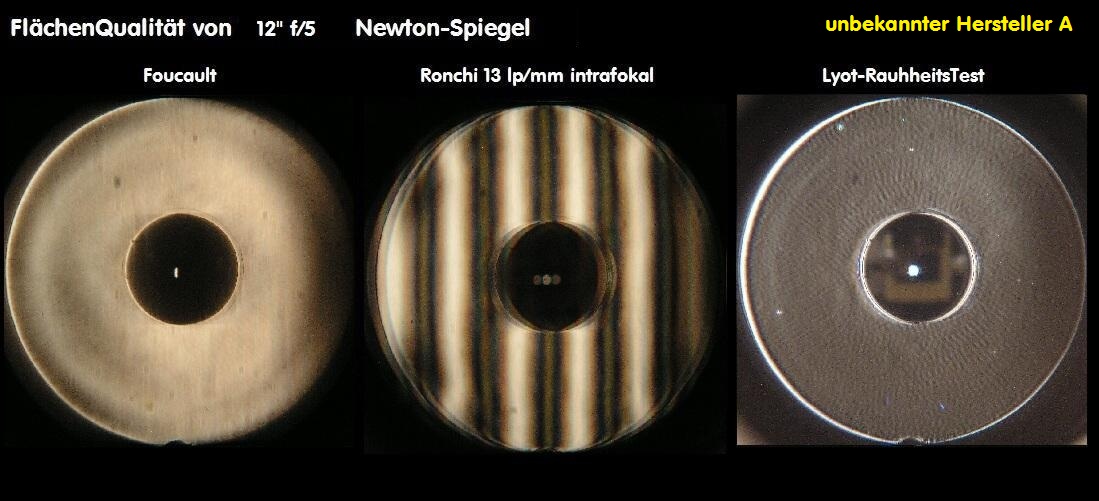
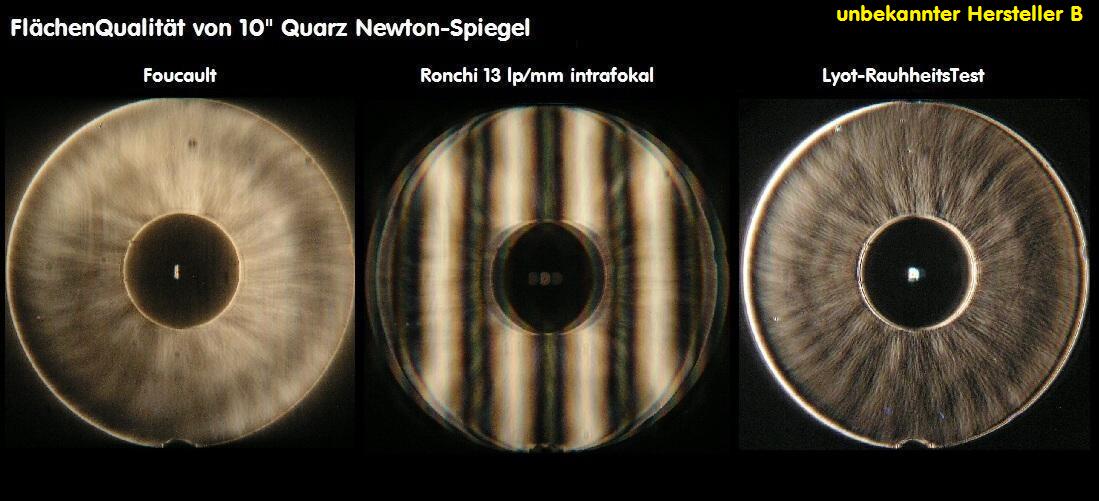
SW 300p secondary mirror size
in Discussions - Scopes / Whole setups
Posted
I have the GSO dob with very nearly the same specs, 300mm f/5, and the secondary size is 70mm.